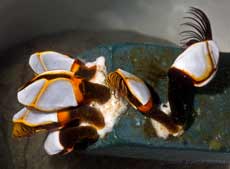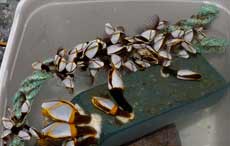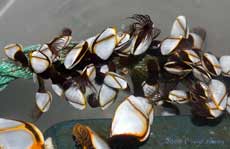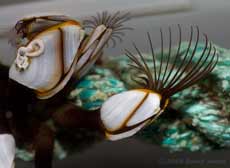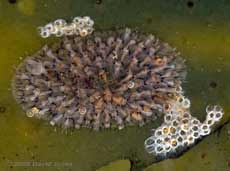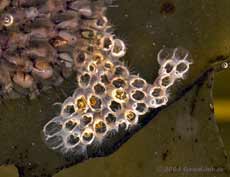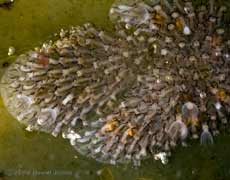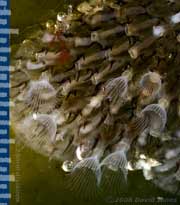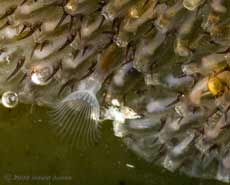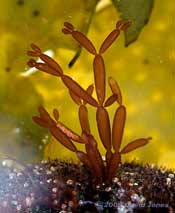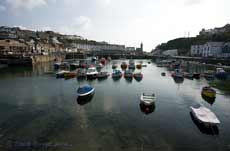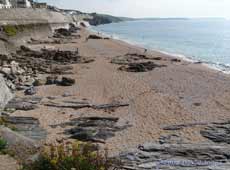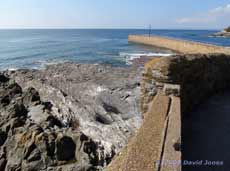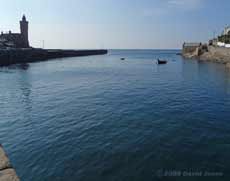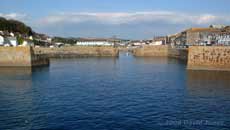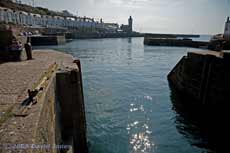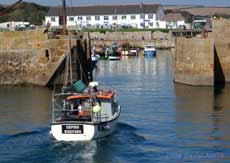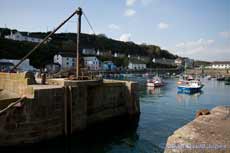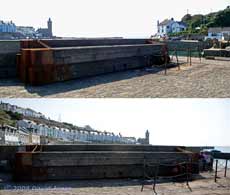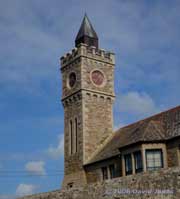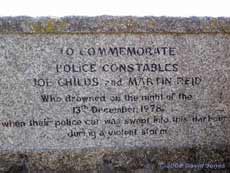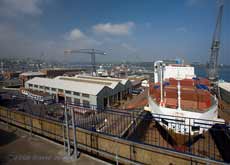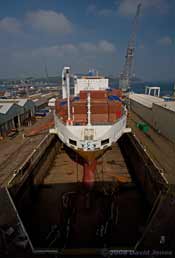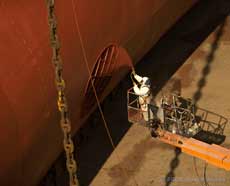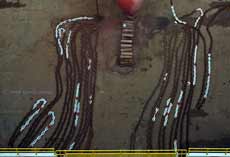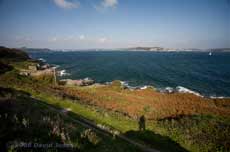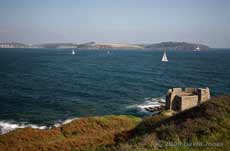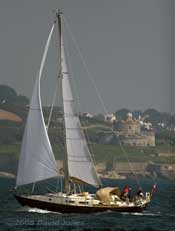Go to the last entry on this page .....Go to previous entry24 September - The dry weather continues, although it took all morning for the cloud cover to give way to sunshine, and the easterly wind continues - perhaps a bit less strong today. As the tides head for the neap part of their cycle, Porthallow Cove continues to be subject to a swell that brings in more seaweed and flotsam, which included a return visit from the Goose Barnacles on their plastic raft.
In this shot the shape of the barnacle at the centre-left, resembling the neck and head of a goose gives an idea as to why it gets its name.
As the tide receded, I walked along the strand line to the right of the cove. Just when I was about to head back when I had that feeling one gets when having waited ages for a bus, a whole lot turn up! I came across a large, tangled mass of rope, freshly stranded up and covered with hundreds of Goose Barnacles on it. There was no chance that I could do anything with the mass, so I cut off a short length of the rope so that I could compare these barnacles with those on the plastic.
As you can see, they are much smaller,
and they all had dark filter appendages. After taking these photographs both the plastic and rope were returned to the sea as the tide continued to ebb in the forlorn hope that one or the other will not get washed back in with the next tide.
A couple of bits of seaweed that I picked up of the strandline had living colonies of bryozoans on them so I decided to try a few photographs. In this group you can see the how the individual organisms (zooids) radiate out from the centre of the colony on Toothed Wrack (Fucus serratus). The whole colony has been produced from one sexually produced individual by asexual budding, so that they are genetically identical. As a result, the whole colony is usually regarded as a single colonial organism.4
I was surprised to see groups of tentacles amongst the skeletal remains at the bottom-right of the previous photograph. They suggest that these zooids only died very recently. I also noticed a few tentacle groups floating in the water.
It took quite a while for the live zooids to become active again, and even then there wasn't a great deal of activity.
A bryozoan has a bell-shaped ring of ciliated tentacles (known as an Iophophore) around a mouth that leads into a U-shaped gut. When the zooid is going to feed it extends the structure out with the tentacles closed up together, and once fully extended they suddenly pop out into the characteristic bell shape. When something is caught up in the cilia disturbed, the Iophophore is retracted at high speed, catching me out numerous times as I tried to photograph them.
The dark spines around the perimeter of each zooid suggests that these bryozoans is likely to be Electra pilosa (Hairy Sea-mat)
Just one seaweed picture today, not of the Toothed Wrack that the bryozoans were on, but of a tiny seaweed that was growing amongst those zooids. I'm not going to try an identification - is it a very small species (it measures not much more than 1cm in height) or a young example of a larger species? I can see bubbles in one of the left-hand branches, suggesting that the structures are hollow.
25 September - With the good weather continuing (and forecast to continue) we decided on a 'sort of' day of rest today,
and spent much of it doing very little next to the fishing harbour of Porthleven. At low tide most of the boats seen here are left high and dry.
Porthleven is right at the corner where the Lizard peninsula meets the main part of Western Cornwall. Walk down the left side of the harbour to the sea and look left - on a clear day (a bit too hazy today) and you look south along much of the west coast of the Lizard. The beach marks the end of a long sweep of sand and pebbles called Loe Bar, and has lovely, small rounded gravel as well as sand.
Turn to the right, and beyond the breakwater the coast curves round to the west, and the coast beyond Penzance is just visible in the haze.
Looking out at the breakwater from the entrance channel for the harbour you can see just how calm it was today - it's not always like that here!
Turn to look into the harbour and you can see clues as to why the locals watch the weather forecasts with some care. There are two entrances to the harbour, the first wide and the second much narrower into the inner harbour.
Also seen from the other direction, neither entrance faces directly towards the sea.
As a boat sails in through the inner entrance, it passes through a gap that can be closed when south-westerly storms are forecast.
On either side of the entrance there is a vertical steel slot,
and to protect the inner harbour from rough seas, very large timbers are lowered down into them. To give an idea of the size of these timbers, Sheila is sitting and reading a newspaper to the right of the lower photograph.
The tower seen in the background of the previous photograph is often featured in news photographs after a bad south-westerly storm.
The risk to the harbour from storms is a very real one, and this plaque, next to the timbers shown above, records a tragedy that occurred here in 1978. On a day like today, it's difficult to picture how rough the sea can get here. In the past we have seen it quite bad here, but even that didn't warrant the use of the timbers!
26 September - With the easterly breezes continuing we decided to take a trip to Falmouth today.
While Falmouth is a very busy sailing port, we bypassed the centre of the town, with its views of the yachts to head first to the docks, or rather a road that overlooks them.
Falmouth docks are always very busy with maintenance or repair work going on, and from this vantage point you can look down into one of the large dry docks.
This container ship is obviously in for a coat of paint below the water line, amongst other jobs. This was the only activity I could see taking place which leads to the question - 'How long would it take one man with a spray gun to complete the job?'
When I get home I must look up the the units of length used to measure an anchor chain. I understand that they are measured in shackles, but I don't know what actual length that represents. I guess that the red links (are they shackle marks?) should be the same number of links apart, although I'm not sure that they are. It was a pity that the ends of the loops and much of the anchors were hidden from view. ************************** A Note added once we were home again - I have now confirmed that anchor chains are measured in units called shackles, or 'shots of chain', each shot being 15 fathoms, or 90ft in length. Each shot is linked to the next one by a shackle (usually a Kenter lugless shackle), and a ship usually has between 8 and 12 shots of chain attached to each anchor. It still doesn't explain why the distances between the red links vary - the number of links varies from 83 down to 72 links. **************************
In this picture, the settlement you can just make out in the right-hand background is St. Mawes. Falmouth and its docks are hidden to the left of the picture, on the bank of what is in fact the Penryn River.
Turning to the right you look out into Falmouth Bay, with St Mawes on the left and the white buildings of the St. Anthony lighthouse on the right. I had hoped to take some photographs looking across the Bay westwards towards Porthallow but a haze and the bright sunshine made that impossible.
The importance of the harbour has meant that there have been defences here for hundreds of years, and there are remains all around the Point Situated on top of Pendennis Point is Pendennis Castle. I haven't photographed that, but on the other side of the water, and through the haze, you can see St Mawes Castle behind one of the many yachts that are constantly entering or leaving the harbour.
Click on images to see larger versions |
|
